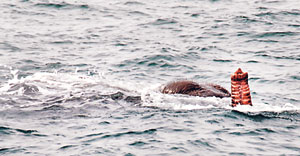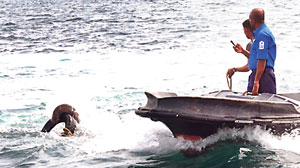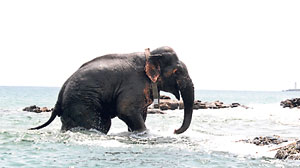He was uprooted from his home and dumped in a place he didn’t know and want to be. This compelled him to walk out, for he was not willing to accept his karma with resignation, he was young and ready to take on the world. He did not venture out for only a little distance but many kilometres through hostile terrain, finally ending up on the beach, far from home and totally lost.
Did he think it was a wewa (tank) where he bathed as a baby with his mother, secure in the knowledge that he is in a country which cherishes him and his kind? Or did he, deep inside, feel rejection, for though the most sacred object in the country is carried by one of his kind, he was chased and vilified, harassed and peppered with bullets and blinded in one eye? Is that why he walked into the sea, because he wanted to get away?
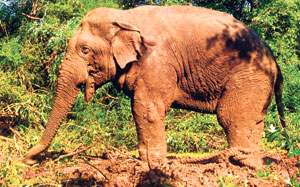 |
| Brigadier just before translocation |
Of course, no one will know, but who cares, in a country where people pay only lip service to protecting them but the reality is a far cry.
There were, however, a few who cared enough – when they spotted him in trouble or literally “deep water” off Sampur.
This is a snapshot of the life of a young and troubled bull elephant who has been a bit dhaamara (thuggish) because that was the only way he could find something to eat.
Deduru Oya area, particularly close to the government farm at Thelahera had been his home along with three other bull elephants and brings into sharp focus the human-elephant conflict which has been plaguing the country.
With more and more land being cleared and elephants losing their home habitat to humans, these majestic creatures know no other life. “Elephants are becoming more aggressive and coming into developed areas,” said Dr. Prithiviraj Fernando of the Centre for Conservation and Research, pointing out that conflict seems to be the only life they are compelled to know.
Those days elephants wouldn’t come into towns but now they have been forced to adapt and change their behaviour because of what we have done to them, he says.
Yes, this stocky and well-built bull-elephant, not even 20 years old, with numerous gun-shot injuries was raiding homesteads because for him paddy is tastier than the dried up leaves he had for fodder in the jungle. But is he the miscreant or the victim in this pathetic human-elephant conflict which seems to be heavily-weighted in favour of humans wielding guns, with bureaucracy behind them.
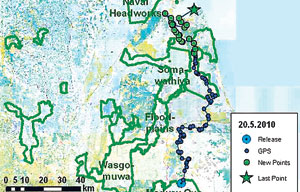 |
| The route the elephant took |
Whenever there are elephant issues, the first solution that is suggested is translocation of the elephant from its home-ground. Shouldn’t the authorities find ways and means of protecting the people and their homes while the elephants remain in the area? Shouldn’t also people and development agencies take responsibility for these problems of unplanned development without pressurising the Department of Wildlife Conservation (DWC) to translocate the elephants?
According to news reports this bull-elephant made a grievous mistake – he went in search of food to the home of a high-level army official and foraged on the stored paddy there, causing much damage. A hue and cry followed and the elephant was tranquillized, captured, collared (with a radio to track his movements) and translocated to the Maduru Oya National Park on April 28, 126 km from his home.
Named ‘Brigadier’ after his brush with the army officer, this eight-foot bull-elephant just would not have it…….he simply walked out of the National Park, taking “charge” of his life.
The radio-collar gave the feedback of his position. He went up north, along the Mahaweli Ganga, through Somawathiya, where the floods didn’t deter him, but later turned east and ended up in Sampur. The collar obviously didn’t work when he got into the sea but after the Navy rescued him it did give weak signals, with the data being transmitted from somewhere in the Sampur jungle on May 22.
With a 16-hour gap between transmissions from the collar, maybe due to salt water which is the “worst” for such collars according to Dr. Fernando, on May 20 and 21 it worked again indicating Brigadier was back on Sampur shore. As there was no data on May 22, worried DWC officials began a search for Brigadier who by then had walked 177 km without considering his near-drowning off Sampur.
They did locate him at Foul Point, once again with the help of the Navy, and according to th Acting Deputy Director of Wildlife Health, Dr. Tharaka Prasad he will be in th area over the weekend to remove the noose and check out Brigadier .
At least for now Brigadier is in safe hands under the DWC but what of this young bull-elephant’s future?
Operation jumbo rescue
It was at first light on May 19 that they spotted him, like a big black rock off Norway Island. They had been on night patrols off Trincomalee and wondered whether it was a thalmaha (whale).
As they edged closer, they were in for a surprise – for suddenly they spotted a raised trunk spurting out water.
“It was an elephant,” says Petty Officer B.M.N. Basnayake who was manning the naval water-jet, while Leading Seaman M.M.K.R. Madanayake who joined him as soon as his water-jet heard the news, adds that the animal was being swept farther out due to the strong current.
They immediately informed the office of the Commander Eastern Naval Area at the Trincomalee Dockyard and as it was a “different kind of operation” Deputy Area Commander Commodore Sisira Jayakody in turn informed Navy Commander Vice Admiral Thisara Samarasinghe, the Media Spokesman for the Navy, Capt. Athula Senarath told the Sunday Times.
Things happened quickly thereafter, with Vice Admiral Samarasinghe’s immediate “Go ahead”.
The water-jets then attempted to gradually surround the elephant in distress, by now about three nautical miles out at sea, and manoeuvre him towards land without causing harm to the animal as ordered by the Navy top brass. “But the current was too strong,” says Petty Officer Basnayake.
It was then that they decided to get the expertise of their skilled divers. “We had just got back to the diving office around 8 a.m. after underwater inspections, when we were summoned.” Come as soon as possible, Able Divers H.G.A.S. Amarasinghe and J.M.R.I. Herath were told because “aliyek pawela yanawa” (an elephant was floating away).
When they got there, they dropped a rope first and then even a tyre and the desperate elephant did pick them up in its trunk and grab them in its mouth but as it struggled to breathe the safety lines would slip out.
Then the divers dropped into the water and noosed the left hind leg of the elephant. The rope-eye was knotted in a way that it would tighten when noosed around the leg, but once cut would become slack so as not to harm the elephant, the divers explained.The water-jets then drew the elephant towards the Sampur shore. As they neared the rock-strewn beach a smaller boat took up the task with the sailors and divers getting into the water to prevent the elephant from being smashed against the rocks.
The moment Brigadier got on shore he trumpeted and went into the jungle breaking off branches for a quick meal.
Battle-hardened though they were these navy men just couldn’t let him drown and exhausted after this three-hour ‘Operation Jumbo-rescue’ were content that they had saved a life.
A different elephant crossing
In a different twist, comes a tale of how in the 1960s elephants used to cross a short stretch of the sea from Thambalagamuwa to the Naval Dockyard in Trincomalee.
When their fodder area dried up, they are said to have come into the dockyard because it was lush and green, to feast there for about a month before departing, Capt. Senarath said, pointing out that the map of Sri Lanka indicates ‘Elephant Point’ and ‘Elephant Island’.
Soon after the rescue of Brigadier, the family of the late Admiral Clancy Fernando, former Navy Commander, had presented a set of photographs that he had clicked as a young sub-lieutenant based at the dockyard in the 1960s of such an elephant crossing.
However, Brigadier’s is a different story – the story of a lost and desperate young elephant. Why he went to sea, no one will know – we can only speculate that it was cruelty by humans that nearly drove Brigadier to his death.
|



